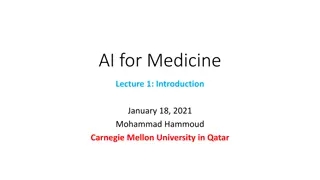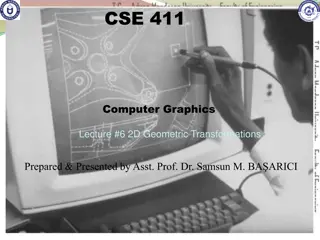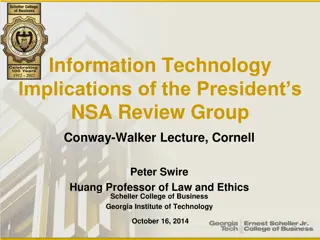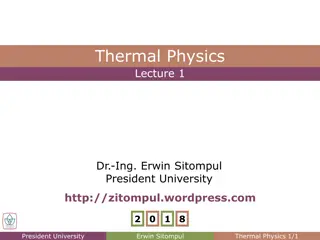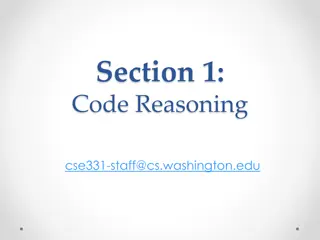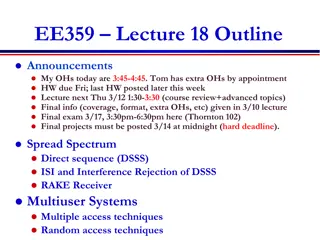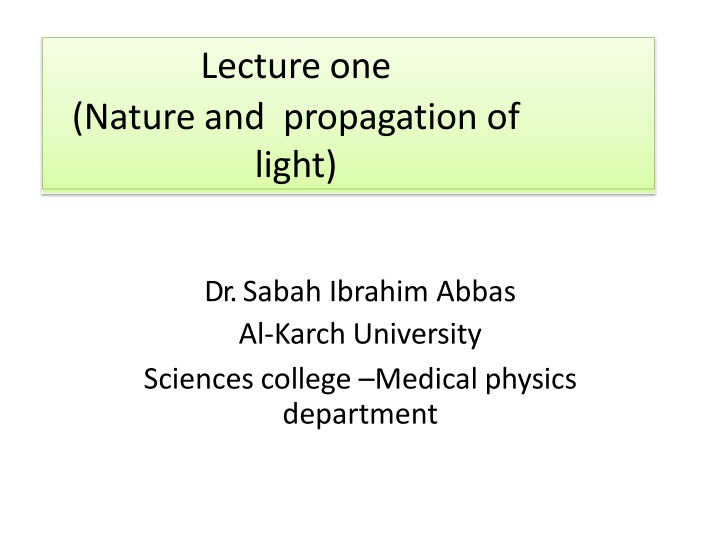
Understanding Light: Nature, Propagation, and Models
Explore the fundamental concepts of light, including its dual nature as both waves and particles, the speed of light in different mediums, the concept of photons, and the wave model of light propagation. Delve into topics such as wave-like properties, particle-like behaviors, the speed of light in vacuum, and the interaction of light with matter. Gain insights into the theories of light presented by notable physicists and understand the essential principles that govern the behavior of light in various contexts.
Download Presentation

Please find below an Image/Link to download the presentation.
The content on the website is provided AS IS for your information and personal use only. It may not be sold, licensed, or shared on other websites without obtaining consent from the author. If you encounter any issues during the download, it is possible that the publisher has removed the file from their server.
You are allowed to download the files provided on this website for personal or commercial use, subject to the condition that they are used lawfully. All files are the property of their respective owners.
The content on the website is provided AS IS for your information and personal use only. It may not be sold, licensed, or shared on other websites without obtaining consent from the author.
E N D
Presentation Transcript
Lecture one (Nature and propagation of light) Dr. Sabah Ibrahim Abbas Al-Karch University Sciences college Medical physics department
Lecture one (Nature and propagation of light) Geometrical Optics By : Dr. SABAH IBRAHIM ABBAS Al-Karakh university of Sciences References: 1- Fundamental of optics by [ Jenkins and white ] 2- Introduction to modern optics by [ Grant R. Fowles
Lecture one (Nature and propagation of light) What is the light? Light has both wave Theory (Huygens s) and particle theory (Newton s) Wave-like: propagation, interference,Diffraction. Particle-like: emission, absorption. Particle-like energy exchange (MODERN: now explained by quantum mechanics) only discrete quanta of energy can be absorbed or emitted, thereforeit must exist in only discrete energy units. In a particle theory of light travels in straight-line paths called light rays represent the paths of particles.
Lecture one (Nature and propagation of light) The speed of light in a vacuum is expressed as c = 2.99 108 m/s. Light travels in a vacuum at a constant speed, and this speed is considered a universal constant. It is important to note that speed changes for light traveling through nonvacuum media such as air (0.03% slower) or glass (30.0% slower). For most purposes, we may represent light in terms of its magnitude and direction. In a vacuum, light will travel in a straight line at fixed speed, carrying energy from one place to another
Lecture one (Nature and propagation of light) Concept of a photon:- The particle-like nature of light is modeled with photons. A photon has no mass and no charge. It is a carrier of electromagnetic energy and interacts with other discrete particles (e.g., electrons, atoms, and molecules). A beam of light is modeled as a stream of photons, each carrying a well-defined energy that is dependent upon the wavelength of the light. Energy (E): measured in J/mole, J/photon, or electron volt (eV, 1eV=1.6 * 10-19 J per photon or per mole of photons). Energy of the wave can be calculated directly from the wavelength or frequency. The energy (E) of a given photon can be calculated by: E = hc/
Lecture one (Nature and propagation of light) Wave Model :- The particle-like model of light describes large-scale effects such as light passing through lenses or bouncing off mirrors. However, a wavelike model must be used to describe fine scale effects such as interference and diffraction that occur when light passes through small openings or by sharp edges. The propagation of light or electromagnetic energy through space can be described in terms of a traveling wave motion. The wave moves energy without moving mass from one place to another at a speed independent of its intensity or wavelength. This wave nature of light is the basis of physical optics and describes the interaction of light with media. Many of these processes require calculus and quantum theory to describe them rigorously.
Lecture one (Nature and propagation of light) Characteristics of light waves
Lecture one (Nature and propagation of light) Wavelength ( ):The distance from one peak to the next, Measured in nanometers (nm), micrometers ( m), or angstroms ( , 1 = 0.1 nm). Wavenumber (?): The wavenumber is how many waves fit in the distance of 1 cm. and measured in inverse centimeters (cm-1). Also the inverse of the wavelength (1/ ) is the wave number (?), which is =1 1 ; ?????? ?? ? The wave propagates at a wave speed (v). This wave speed in a vacuum is equal to c, and is less than c in a medium. At a stationary point along the wave, the wave passes by in a repeating cycle. The time to complete one cycle is called the cycle time or period ( ) and can be calculated =? Period or cycle time is v Frequency (?). It is measured as the number of waves that pass a given point in one second. The unit for frequency is cycles per second, also called hertz(Hz).
Lecture one (Nature and propagation of light) The Electromagnetic Spectrum:- The electromagnetic (EM) spectrum is the range of all types of EM radiation. Radiation is energy that travels and spreads out as it goes the visible light that comes from a lamp in your house and the radio waves that come from a radio station are two types radiation. The other types of EM radiation that make up the electromagnetic spectrum are microwaves, infrared light, ultraviolet, X-rays and gamma rays. of electromagnetic
Lecture one (Nature and propagation of light) Radio: Radio waves are antennas, which consist of conductors such as metal rod resonators. In artificial generation of radio waves, an electronic device called a transmitter generates an AC electric current which is applied to an antenna. The oscillating electrons in the antenna generate oscillating electric and magnetic fields that radiate away from the antenna as radio waves. Radio waves are also emitted by stars and gases in space. Wavelength (300 mm and longer). Microwave: Microwave popcorn in just a few minutes, but is also used by astronomers to learn about the structure of nearby galaxies. emitted and received by radiation will cook your
Lecture one (Nature and propagation of light) Infrared: Night vision goggles pick up the infrared light emitted by our skin and objects with heat. In space, infrared light helps us map the dust betweenstars. Visible: Our eyes detect visible light, light bulbs, and stars all emit visible light. Ultraviolet: Ultraviolet radiation is emitted by the Sun and is the reason skin tans and burns. "Hot" objects in space emit UV radiation as well.is the longest wavelength radiation whose photons are energetic enough to ionize atoms, separating electrons from them, and thus causing chemical reactions. Short wavelength UV and the shorter wavelength radiation above it (X-rays and gamma rays) are called ionizing radiation, and exposure to them can damage living tissue, making them a health hazard. UV can also cause many substances to glow with visible light; this is called fluorescence. At the middle range of UV, UV rays cannot ionize but can break chemical bonds, making molecules unusually reactive. Sunburn, for example, is caused by the disruptive effects of middle range radiation on skin cells, which is the main cause of skin cancer. UV rays in the middle range can irreparably damage the complex DNA molecules in the cells producing thymine dimers making it a very potent mutagen. UV
Lecture one (Nature and propagation of light) X-ray: After UV come X-rays, which, like the upper ranges of UV are also ionizing. However, due to their higher energies, X-rays can also interact with matter by means of the Compton effect. Hard X-rays have shorter wavelengths than soft X-rays and as they can pass through many substances with little absorption, they can be used to 'see through' objects with 'thicknesses' less than that equivalent to a few meters of water. One notable use is diagnostic X-ray imaging in medicine (a process known as radiography). Gamma ray: Doctors use gamma-ray imaging to see inside your body. The biggest gamma-ray generator of all is the Universe. Gamma rays are used experimentally by physicists for their penetrating ability and are produced by a number of radioisotopes. They are used for irradiation of foods and seeds for sterilization, and in medicine they are occasionally used in radiation cancer therapy. More commonly, gamma rays are used for diagnostic imaging in nuclear medicine, an example being PET scans. The wavelength of gamma rays can be measured with high accuracy through the effects of Compton scattering. Lecture one(Nature
Lecture one (Nature and propagation of light) Region Wavelength (nm ) >108 108 105 105 700 400-700 400-1 1- 0.01 Wavelength (m)(nm=10 9?) Frequency(Hz)(THz= 1012 ??) Energ y [e V] <10 5 10 5 0.01 0.01-2 2-3 3-103 103 105 Radio Microwave Infrared Visible Ultraviolet X-Rays >10 1 10 1 10 4 10 4 7 10 7 7*10 7 4 10 7 4*10 7 10 9 10 9 10 11 <3*109 3*109-3*1012 3*1012 4.3 1014 4.3*1014 7.5 1014 7.5*1014 3 1017 3*1017 3 1019 GammaRays <0.01 <10 11 >105 >3 1019
Lecture one (Nature and propagation of light)




